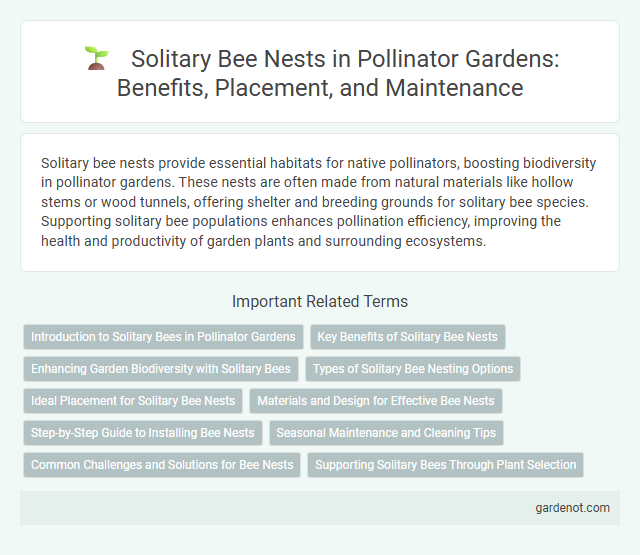Solitary bee nests provide essential habitats for native pollinators, boosting biodiversity in pollinator gardens. These nests are often made from natural materials like hollow stems or wood tunnels, offering shelter and breeding grounds for solitary bee species. Supporting solitary bee populations enhances pollination efficiency, improving the health and productivity of garden plants and surrounding ecosystems.
Introduction to Solitary Bees in Pollinator Gardens
Solitary bees, unlike social bees, build individual nests in natural cavities or soil, playing a crucial role in pollinator gardens by enhancing biodiversity and crop pollination. These bees are highly efficient pollinators, with species such as mason bees and leafcutter bees actively increasing fruit and flower yields. Incorporating solitary bee nests into pollinator gardens supports their life cycles and contributes to sustainable ecological balance.
Key Benefits of Solitary Bee Nests
Solitary bee nests provide essential habitats that support biodiversity and enhance pollination efficiency for a wide range of plants, including fruits, vegetables, and wildflowers. By offering safe nesting sites, these nests boost the population of solitary bees, which are highly effective pollinators due to their specialized foraging behavior and reduced disease transmission compared to social bees. Integrating solitary bee nests into pollinator gardens contributes to agricultural productivity and ecosystem health by promoting native pollinator species and increasing pollination rates.
Enhancing Garden Biodiversity with Solitary Bees
Solitary bee nests provide essential habitats that significantly enhance garden biodiversity by supporting pollination and increasing plant reproduction rates. These bees, unlike social species, nest individually in soil, wood, or hollow stems, promoting diverse ecological interactions within garden ecosystems. Encouraging solitary bee populations through targeted nest sites boosts pollinator diversity and contributes to a more resilient and thriving garden environment.
Types of Solitary Bee Nesting Options
Solitary bees utilize a variety of nesting options, including hollow stems, wood tunnels, and underground burrows, each providing essential shelter and protection for their offspring. Materials like untreated wood blocks with pre-drilled holes, bamboo tubes, and sandy soil patches create ideal habitats that support diverse solitary bee species such as mason bees and leafcutter bees. Providing these specialized nesting environments enhances pollination efficiency and boosts local biodiversity within pollinator gardens.
Ideal Placement for Solitary Bee Nests
Ideal placement for solitary bee nests includes sunny, south-facing locations sheltered from strong winds, ensuring warmth essential for bee development. Nests should be positioned 3 to 5 feet above ground in well-drained areas, avoiding damp or waterlogged soils. Proximity to diverse flowering plants supports foraging while minimizing disturbance from human or animal activity enhances nesting success.
Materials and Design for Effective Bee Nests
Effective solitary bee nests incorporate natural materials such as untreated wood, hollow stems, and bamboo tubes, providing safe and accessible nesting sites for various bee species. Designs featuring varied diameters of holes, ranging from 2 to 10 millimeters, accommodate different species' nesting preferences and enhance occupancy rates. Incorporating protective elements like weather-resistant coverings and positioning nests in sunny, sheltered locations increases larval survival and overall pollinator population support.
Step-by-Step Guide to Installing Bee Nests
Install solitary bee nests by selecting a sunny, sheltered location with well-drained soil to mimic natural habitats. Prepare nesting blocks or tunnels using untreated wood or hollow stems, ensuring holes are 6-10 mm in diameter and 10-15 cm deep for optimal occupancy. Secure the nest structures firmly, maintain cleanliness by removing debris annually, and avoid pesticides to support solitary bee populations effectively.
Seasonal Maintenance and Cleaning Tips
Solitary bee nests require seasonal maintenance to ensure healthy bee populations and prevent parasite buildup. Cleaning involves removing debris and replacing damaged nesting materials in early spring before new bees emerge. Regular inspection and gentle sanitization help maintain optimal nesting conditions and support pollinator health.
Common Challenges and Solutions for Bee Nests
Solitary bee nests often face challenges such as habitat loss, predation, and moisture damage, which can dramatically reduce nesting success rates. Providing nesting blocks with appropriate drilled hole sizes, ensuring dry, well-ventilated locations, and using protective mesh can mitigate these issues. Maintaining natural vegetation around nest sites further supports bee health by offering ample foraging resources and shelter.
Supporting Solitary Bees Through Plant Selection
Supporting solitary bees through strategic plant selection involves choosing native, pollen-rich flowering plants that bloom at various times to provide continuous food sources. Plants like lavender, coneflowers, and wildflowers create ideal habitats, ensuring solitary bees have both nectar and pollen for nourishment and nesting materials. Integrating diverse plant species enhances solitary bee populations, promoting biodiversity and effective pollination within pollinator gardens.
Solitary bee nest Infographic

 gardenot.com
gardenot.com